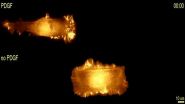New imaging technique could detect acoustically 'invisible' cracks
2014-10-06
(Press-News.org) The next generation of aircraft could be thinner and lighter thanks to the development of a new imaging technique that could detect damage previously invisible to acoustic imaging systems.
The nonlinear acoustic technique developed by researchers from the University of Bristol's Ultrasonics and Non-destructive Testing (NDT) research group is published in the current issue of Physical Review Letters together with an accompanying article in Physics.
It has long been understood that acoustic nonlinearity is sensitive to many physical properties including material microstructure and mechanical damage. The lack of effective imaging has, however, held back the use of this important method.
Currently engineers are able to produce images of the interior of components using ultrasound, but can only detect large problems such as cracks. This is like detecting only broken bones in a medical environment.
Imaging of acoustic nonlinearity is achieved by exploiting differences in the propagation of fields produced by the parallel and sequential transmission of elements in ultrasonic arrays.
Dr Jack Potter, Research Assistant in the Department of Mechanical Engineering, who led the study, said: "Imaging acoustic nonlinearity not only provides sensitivity to smaller defects than is currently possible but may have the potential to detect damage before macroscopic material changes occur.
"This would enable intervention before cracks have even begun to form, as well as predicting the remaining life of an engineering structure. Crucially the technique has been achieved using standard inspection equipment, which will allow for the rapid implementation of the technique in numerous applications."
Such advances in non-destructive evaluation not only increase the safety of engineering structures but can help future design, for example, allowing the next generation of aircraft to be built thinner and lighter.
INFORMATION:
Paper:
'Nonlinear ultrasonic phased array imaging', J. N. Potter, A. J. Croxford, and P. D. Wilcox, Physical Review Letters
ELSE PRESS RELEASES FROM THIS DATE:
2014-10-06
For millennia, bacteria and other microbes have engaged in intense battles of chemical warfare, attempting to edge each other out of comfortable ecological niches. Doctors fight pathogens with an arsenal of weapons—antibiotics—co-opted from these microbial wars, but their efforts are frustrated by the development of drug resistance that outpaces drug discovery. Researchers at the University of Illinois at Urbana-Champaign and Northwestern University have now innovated and demonstrated the value of an algorithm to analyze microbial genomic data and speed discovery of new ...
2014-10-06
This news release is available in Spanish.
Fuel cells are totally appropriate systems for substituting the batteries of mobile phones, laptop computers and vehicles. They turn the energy resulting from the combining of hydrogen and oxygen into electrical power, with water vapour being the only waste product. In other words, they generate energy in the same way that batteries do, but they do not contaminate.
However, if these fuel cells are to produce energy, they need an external supply of hydrogen, and right now storing hydrogen safely poses difficulties. That ...
2014-10-06
BUFFALO, N.Y. – It is not only prenatal drug exposure, but also conditions related to drug use that can influence negative behavior in children, according to a new study from the University at Buffalo's Research Institute on Addictions.
In examining the long-term effects of cocaine use during pregnancy in a sample of low-income, cocaine-exposed and non-exposed families, researchers found that a mother's harshness toward her child during mother-child interactions at 2 years of age is one of the strongest predictors of problem behaviors in kindergarten, such as fighting, ...
2014-10-06
A new paper from the Wildlife Conservation Society, Montana State University, Montana Department of Fish, Wildlife and Parks, and the U.S. Geological Survey looks at the feasibility of electrofishing to selectively remove invasive trout species from Montana streams as an alternative to using fish toxicants known as piscicides that effect all gill-breathing organisms.
Westslope Cutthroat Trout (WCT) have experienced severe declines throughout much of their historical range. One major reason for this decline is the current competitive advantages enjoyed by non-native Brook ...
2014-10-06
Reducing community transmission and changing behaviour in communities is key to containing Ebola outbreaks, according to new research into the first known outbreak of the virus in 1976 by researchers at the London School of Hygiene & Tropical Medicine and Fogarty International Center at the National Institutes of Health.
The study authors include Professor Peter Piot and Dr Joel Breman, who travelled to Zaire (now the Democratic Republic of Congo), to investigate the first outbreak in 1976. The study, published in Epidemics, also found that if the people in the affected ...
2014-10-06
By studying identical twins, researchers from Lund University in Sweden have identified mechanisms that could be behind the development of type 2 diabetes. This may explain cases where one identical twin develops type 2 diabetes while the other remains healthy.
The study involved 14 pairs of identical twins in Sweden and Denmark. One twin had type 2 diabetes and the other was healthy.
"Twins are a good model for finding mechanisms, but the results are applicable to all", said Emma Nilsson, who carried out the study with Charlotte Ling.
We know that fat tissue can ...
2014-10-06
Worldwide there have been 71 documented cases of patients with anaplastic large cell lymphoma (ALCL) in which researchers suspected breast implants to be the cause. ALCL is normally found in the lymph nodes, as well as in skin, lung, liver and soft tissue, but not usually in the breast. Cases in which ALCL developed in the breast region almost exclusively involved patients who have had breast surgery. In these cases, ALCL developed around ten years after the operation. The tumours grew in the scar tissue around the implant.
Breast implants are generally safe and studies ...
2014-10-06
New theoretical physics models could help us better grasp the atmospheric chemistry of ozone depletion. Indeed, understanding photoabsorption of nitrous oxide (N2O) — a process which involves the transfer of the energy of a photon to the molecule — matters because a small fraction of N2O reacts with oxygen atoms in the stratosphere to produce among others nitric oxide (NO). The latter participates in the catalytic destruction of ozone (O3). Now, new theoretical work unveils the actual dynamic of the photoabsorption of nitrous oxide molecules. These findings by Mohammad ...
2014-10-06
VIDEO:
The cell stimulated with the growth factor PDGF (upper cell) migrates targeted in only one direction on its track, while the not stimulated cell (lower cell) changes its direction of...
Click here for more information.
During cancer metastasis, immune response or the development of organisms, cells are moving in a controlled manner through the body. Researchers from the Department of Biomedicine at the University of Basel discovered novel mechanisms of cell migration by ...
2014-10-06
Viruses can convert their DNA from solid to fluid form, which explains how viruses manage to eject DNA into the cells of their victims. This has been shown in two new studies carried out by Lund University in Sweden.
Both research studies are about the same discovery made for two different viruses, namely that viruses can convert their DNA to liquid form at the moment of infection. Thanks to this conversion, the virus can more easily transfer its DNA into the cells of its victim, which thus become infected. One of the studies investigated the herpes virus, which infects ...
LAST 30 PRESS RELEASES:
[Press-News.org] New imaging technique could detect acoustically 'invisible' cracks


